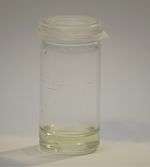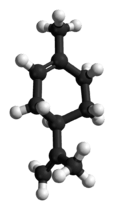Limonene
| |||
 | |||
| Names | |||
|---|---|---|---|
| Preferred IUPAC name
1-Methyl-4-(prop-1-en-2-yl)cyclohex-1-ene | |||
| Other names
1-Methyl-4-(1-methylethenyl)cyclohexene 4-Isopropenyl-1-methylcyclohexene p-Menth-1,8-diene Racemic: DL-Limonene; Dipentene | |||
| Identifiers | |||
3D model (JSmol) |
|||
| ChEBI | |||
| ChEMBL |
| ||
| ChemSpider | |||
| ECHA InfoCard | 100.028.848 | ||
| KEGG | |||
PubChem CID |
|||
| UNII |
| ||
| |||
| |||
| Properties | |||
| C10H16 | |||
| Molar mass | 136.24 g·mol−1 | ||
| Appearance | colorless to pale-yellow liquid | ||
| Odor | Orange | ||
| Density | 0.8411 g/cm3 | ||
| Melting point | −74.35 °C (−101.83 °F; 198.80 K) | ||
| Boiling point | 176 °C (349 °F; 449 K) | ||
| insoluble | |||
| Solubility | miscible in ethanol, benzene, chloroform, ether, CS2, and oils soluble in CCl4 | ||
Chiral rotation ([α]D) |
87° – 102° | ||
Refractive index (nD) |
1.4727 | ||
| Thermochemistry | |||
Std enthalpy of combustion (ΔcH |
−6.128 MJ mol−1 | ||
| Hazards | |||
| Main hazards | Skin sensitizer / Contact dermatitis – After aspiration, pulmonary oedema, pneumonitis, and death [1] | ||
| GHS pictograms |     | ||
| GHS signal word | Danger | ||
| H226, H304, H315, H317, H400, H410 | |||
| P210, P233, P240, P241, P242, P243, P261, P264, P272, P273, P280, P301+330+331, P302+352, P303+361+353, P304+340, P312, P333+313, P362, P370+378, P391, P403+233, P235, P405, P501 | |||
| NFPA 704 | |||
| Flash point | 50 °C (122 °F; 323 K) | ||
| 237 °C (459 °F; 510 K) | |||
Except where otherwise noted, data are given for materials in their standard state (at 25 °C [77 °F], 100 kPa). | |||
| Infobox references | |||
Limonene is a colorless liquid aliphatic hydrocarbon classified as a cyclic monoterpene, and is the major component in the oil of citrus fruit peels.[2] The D-isomer, occurring more commonly in nature as the fragrance of oranges, is a flavoring agent in food manufacturing.[2][3] It is also used in chemical synthesis as a precursor to carvone and as a renewables-based solvent in cleaning products.[2] The less common L-isomer is found in mint oils and has a piny, turpentine-like odor.[2]
Limonene takes its name from the peel of the lemon. Limonene is a chiral molecule, and biological sources produce one enantiomer: the principal industrial source, citrus fruit, contains D-limonene ((+)-limonene), which is the (R)-enantiomer.[2] Racemic limonene is known as dipentene.[4] D-Limonene is obtained commercially from citrus fruits through two primary methods: centrifugal separation or steam distillation.
Chemical reactions
Limonene is a relatively stable monoterpene and can be distilled without decomposition, although at elevated temperatures it cracks to form isoprene.[5] It oxidizes easily in moist air to produce carveol, carvone, and limonene oxide.[6][7] With sulfur, it undergoes dehydrogenation to p-cymene.[8]
Limonene occurs commonly as the D- or (R)-enantiomer, but racemizes to dipentene at 300 °C. When warmed with mineral acid, limonene isomerizes to the conjugated diene α-terpinene (which can also easily be converted to p-cymene). Evidence for this isomerization includes the formation of Diels–Alder adducts between α-terpinene adducts and maleic anhydride.
It is possible to effect reaction at one of the double bonds selectively. Anhydrous hydrogen chloride reacts preferentially at the disubstituted alkene, whereas epoxidation with mCPBA occurs at the trisubstituted alkene.
In another synthetic method Markovnikov addition of trifluoroacetic acid followed by hydrolysis of the acetate gives terpineol.
Biosynthesis
In nature, limonene is formed from geranyl pyrophosphate, via cyclization of a neryl carbocation or its equivalent as shown.[9] The final step involves loss of a proton from the cation to form the alkene.

The most widely practiced conversion of limonene is to carvone. The three-step reaction begins with the regioselective addition of nitrosyl chloride across the trisubstituted double bond. This species is then converted to the oxime with a base, and the hydroxylamine is removed to give the ketone-containing carvone.[3]
Safety and research
D-Limonene applied to skin may cause irritation from contact dermatitis, but otherwise appears to be safe for human uses.[10][11] Limonene is flammable as a liquid or vapor, and is toxic to aquatic life.[2] There is no evidence for efficacy or regulatory approval of perillyl alcohol – the precursor for D-limonene – as a chemotherapeutic agent.[12][13]
Uses
Limonene is common as a dietary supplement and as a fragrance ingredient for cosmetics products.[2] As the main fragrance of citrus peels, D-limonene is used in food manufacturing and some medicines, such as a flavoring to mask the bitter taste of alkaloids, and as a fragrance in perfumery, aftershave lotions, bath products, and other personal care products.[2] D-Limonene is also used as botanical insecticide.[2][14] D-Limonene is used in the organic herbicide "Avenger".[15] It is added to cleaning products, such as hand cleansers to give a lemon or orange fragrance (see orange oil) and for its ability to dissolve oils.[2] In contrast, L-limonene has a piny, turpentine-like odor.
Limonene is used as a solvent for cleaning purposes, such as the removal of oil from machine parts, as it is produced from a renewable source (citrus oil, as a byproduct of orange juice manufacture). It is used as a paint stripper and is also useful as a fragrant alternative to turpentine. Limonene is also used as a solvent in some model airplane glues and as a constituent in some paints. Commercial air fresheners, with air propellants, containing limonene are used by philatelists to remove self-adhesive postage stamps from envelope paper.[16]
Limonene is also used as a solvent for filament-fused 3D printing.[17] Printers can print the plastic of choice for the model, but erect supports and binders from HIPS, a polystyrene plastic that is easily soluble in limonene. As it is combustible, limonene has also been considered as a biofuel.[18]
In preparing tissues for histology or histopathology, D-limonene is often used as a less toxic substitute for xylene when clearing dehydrated specimens. Clearing agents are liquids miscible with alcohols (such as ethanol or isopropanol) and with melted paraffin wax, in which specimens are embedded to facilitate cutting of thin sections for microscopy.[19][20][21] In traditional medicine, D-limonene is marketed to relieve gallstones, gastroesophageal reflux disease, and heartburn,[22] although none of these supposed effects is confirmed by high-quality clinical research.
See also
References
- ↑ GHS Classification on [PubChem]
- 1 2 3 4 5 6 7 8 9 10 "D-Limonene". PubChem Compound Database. National Center for Biotechnology Information, US National Library of Medicine. 2017. Retrieved 22 December 2017.
- 1 2 Fahlbusch, Karl-Georg; Hammerschmidt, Franz-Josef; Panten, Johannes; Pickenhagen, Wilhelm; Schatkowski, Dietmar; Bauer, Kurt; Garbe, Dorothea; Surburg, Horst (2003). "Flavors and Fragrances". Ullmann's Encyclopedia of Industrial Chemistry. doi:10.1002/14356007.a11_141. ISBN 978-3-527-30673-2.
- ↑ Simonsen, J. L. (1947). The Terpenes. 1 (2nd ed.). Cambridge University Press. OCLC 477048261.
- ↑ Pakdel, H. (2001). "Production of DL-limonene by vacuum pyrolysis of used tires". Journal of Analytical and Applied Pyrolysis. 57: 91–107. doi:10.1016/S0165-2370(00)00136-4.
- ↑ https://webbook.nist.gov/cgi/cbook.cgi?ID=C13837757
- ↑ Karlberg, Ann-Therese; Magnusson, Kerstin; Nilsson, Ulrika (1992). "Air oxidation of D-limonene (the citrus solvent) creates potent allergens". Contact Dermatitis. 26 (5): 332–340. doi:10.1111/j.1600-0536.1992.tb00129.x. PMID 1395597.
- ↑ Weitkamp, A. W. (1959). "I. The Action of Sulfur on Terpenes. The Limonene Sulfides". Journal of the American Chemical Society. 81 (13): 3430–3434. doi:10.1021/ja01522a069.
- ↑ Mann, J. C.; Hobbs, J. B.; Banthorpe, D. V.; Harborne, J. B. (1994). Natural Products: Their Chemistry and Biological Significance. Harlow, Essex: Longman Scientific & Technical. pp. 308–309. ISBN 0-582-06009-5.
- ↑ Kim, Y.-W.; Kim, M.-J.; Chung, B.-Y.; Bang Du, Y.; Lim, S.-K.; Choi, S.-M.; Lim, D.-S.; Cho, M.-C.; Yoon, K.; Kim, H.-S.; Kim, K.-B.; Kim, Y.-S.; Kwack, S.-J.; Lee, B.-M. (2013). "Safety evaluation and risk assessment of D-Limonene". Journal of Toxicology and Environmental Health, Part B. 16 (1): 17–38. doi:10.1080/10937404.2013.769418. PMID 23573938.
- ↑ Deza, Gustavo; García-Bravo, Begoña; Silvestre, Juan F; Pastor-Nieto, Maria A; González-Pérez, Ricardo; Heras-Mendaza, Felipe; Mercader, Pedro; Fernández-Redondo, Virginia; Niklasson, Bo; Giménez-Arnau, Ana M; GEIDAC (2017). "Contact sensitization to limonene and linalool hydroperoxides in Spain: A GEIDAC*prospective study". Contact Dermatitis. 76 (2): 74–80. doi:10.1111/cod.12714. PMID 27896835.
- ↑ Da Fonseca, C. O; Simão, M; Lins, I. R; Caetano, R. O; Futuro, D; Quirico-Santos, T (2011). "Efficacy of monoterpene perillyl alcohol upon survival rate of patients with recurrent glioblastoma". Journal of Cancer Research and Clinical Oncology. 137 (2): 287–93. doi:10.1007/s00432-010-0873-0. PMID 20401670.
- ↑ "Perillyl Alcohol". Memorial Sloan Kettering Cancer Center. 24 September 2015. Retrieved 14 August 2018.
- ↑ EPA Fact Sheet on Limonene, September 1994
- ↑ Avenger Material Safety Data Sheet http://nebula.wsimg.com/07de45c0af774ba73e06362ad1a56f06?AccessKeyId=C67FD801C8FC93742D64&disposition=0&alloworigin=1
- ↑ Butler, Peter (October 2010). "It's Like Magic; Removing Self-Adhesive Stamps from Paper" (PDF). American Philatelist. American Philatelic Society. 124 (10): 910–913.
- ↑ "Using D-Limonene to Dissolve 3D Printing Support Structures". Fargo 3D Printing. April 26, 2014. Retrieved December 30, 2015.
- ↑ Cyclone Power to Showcase External Combustion Engine at SAE Event, Green Car Congress, 20 September 2007
- ↑ Wynnchuk, Maria (1994). "Evaluation of Xylene Substitutes For A Paraffin Tissue Processing". Journal of Histotechnology (2): 143–9. doi:10.1179/014788894794710913.
- ↑ Carson, F. (1997). Histotechnology: A Self-Instructional Text. Chicago, IL: ASCP Press. p. 28–31. ISBN 0-89189-411-X.
- ↑ Kiernan, J. A. (2008). Histological and Histochemical Methods (4th ed.). Bloxham, Oxon. pp. 54, 57. ISBN 978-1-904842-42-2.
- ↑ Sun, J. (2007). "D-Limonene: safety and clinical applications" (PDF). Alternative Medicine Review. 12 (3): 259–264. PMID 18072821.
- ↑ Hillig, Karl W (October 2004). "A chemotaxonomic analysis of terpenoid variation in Cannabis". Biochemical Systematics and Ecology. 32 (10): 875–891. doi:10.1016/j.bse.2004.04.004. ISSN 0305-1978.
- ↑ Stojković, Dejan; Soković, Marina; Glamočlija, Jasmina; Džamić, Ana; Ćirić, Ana; Ristić, Mihailo; Grubišić, Dragoljub (October 2011). "Chemical composition and antimicrobial activity of Vitex agnus-castus L. fruits and leaves essential oils". Food Chemistry. 128 (4): 1017–1022. doi:10.1016/j.foodchem.2011.04.007. ISSN 0308-8146.


